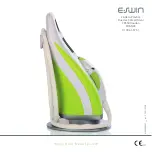
52
53
❙
PRECAUTIONS FOR USE
Never let either the base or the applicator come into
contact with water. Never open the base or the applicator
as you could be exposed to high voltage. Never use
optic
cartridges and accessories other than those designated and
sold for
and by E-SWIN SAS.
❙
ENVIRONMENTAL PROTECTION
Please comply with local regulations when disposing of
packaging and consumables. Wherever possible, try to
promote recycling.
STANDARDS
❙
CERTIFICATIONS
E-SWIN SAS, the company that is the exclusive manufacturer
of the device
has been awarded an ISO 13485
certification.
❙
COMPLIANCE
E-Swin SAS declares that
complies with the essen-
tial requirements of Directive 93/42/EEC, Annex II, Article
3 and has the CE mark under the responsibility of the TUV.
This device therefore complies with the requirements and
standards: EN 60601-1, EN 60601-1-2, EN 60601-1-6, EN
60601-1-11.
TECHNICAL CHARACTERISTICS
ELECTROMAGNETIC IMMUNITY
NOTE 1:
UT is the a.c mains voltage prior to application of the test level.
NOTE 2:
At 80 MHz and 800 MHz, the higher frequency range applies.
NOTE 3:
These guidelines may not apply in all situations. Electromagnetic propagation is affected by absorption an reflection from
structures, objects and peoples.
Field strengths from fixed transmitters, such as base stations for radio (cellular/cordless) telephones and land mobile radios, amateur
radio, AM and FM radio broadcast and TV broadcast cannot be predicted theoretically with accuracy. To assess the electromagnetic
environment due to fixed RF transmitters, an electromagnetic site survey should be considered. If the measured field strength in the
location in which
is used exceed the applicable RF compliance level above,
should be observed to verify normal
operation. If abnormal performance is observed, additional measures may be necessary, such as reorienting or relocating
.
Over the frequency range 150 kHz to 80 MHz, field strength should be less than 3 V/m.
RECOMMENDED SEPARATION DISTANCES BETWEEN PORTABLE
AND MOBILE RF COMMUNICATIONS EQUIPMENT AND
is intended for use in an electromagnetic environment in which radiated RF disturbances are controlled. The customer or user of
can help prevent electromagnetic interference by maintaining a minimum distance between portable and mobile RF communi-
cation equipment (transmitters) and
, as recommended below, according to the maximum output power of the communications
equipment.
Rates max. output power of
transmitter - (W)
Separation distance according to frequency of transmitter (m)
150 Hz to 80 MHz (d = 1,2 √P)
80 MHz to 800 MHz (d = 1,2 √P)
800 MHz to 2,5 GHz (d = 2,3 √P)
0,01
0,12
0,12
0,24
0,1
0,37
0,37
0,74
1
1,20
1,20
2,24
10
3,70
3,70
7,40
100
12
12
24
For transmitters rated at a maximum output power not listed above, the recommended separation distance d in meters (m) can be
estimated using the equation applicable to the frequency of the transmitter, where P is the maximum output power rating of the
transmitter in watts (W) according to the transmitter manufacturer.
NOTE 1:
At 80 MHz and 800 MHz, the separation distance for the higher frequency range applies.
NOTE 2:
These guidelines may not apply in all situations. Electromagnetic propagation is affected by absorption and reflection from
structures, objects and people.



































